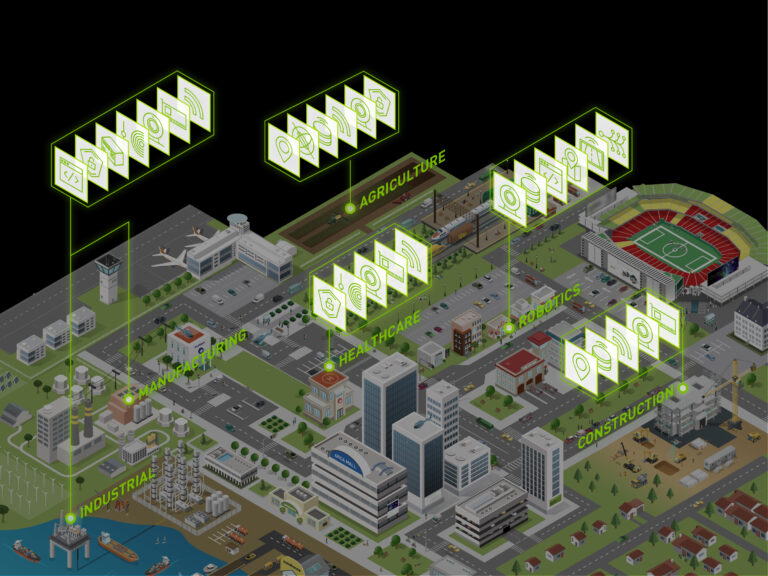 A new generation of AI applications at the edge is driving incredible operational efficiency and safety gains across a broad range of spaces. Read how the power of AI and edge computing is critical to building smarter and safer spaces.
A new generation of AI applications at the edge is driving incredible operational efficiency and safety gains across a broad range of spaces. Read how the power of AI and edge computing is critical to building smarter and safer spaces.

In an increasingly complex world, the need to automate and improve operational efficiency and safety in our physical spaces has never been greater. Whether it is streamlining the retail experience, tackling traffic congestion in our growing cities, or improving productivity in our factories—the power of AI and edge computing is critical.
Video cameras are one of the most important IoT sensors. With approximately 1 billion cameras deployed worldwide, they generate a wealth of data that, when combined with AI-enabled perception and reasoning, is key to transforming ordinary areas into smart spaces.
As the number of IoT sensors grows, more data is getting generated in remote edge locations. Sending data from sensors at the edge to data centers is extremely costly. However, data movement is critical for the successful operation of AI applications, which means that these applications are susceptible to high costs and latency when processing through the cloud. Sending the data to data centers is not ideal in contexts where every second counts, such as managing real-time traffic or addressing medical emergencies.
This leads us to edge computing, a distributed computing model that allows computing to take place near the sensor where data is being collected and analyzed.
Edge computing is the technology that powers edge AI, an architecture that processes the sensor data with deep learning algorithms close to the sensors generating the data. Edge AI enables any device or computer to process data and make decisions in real-time with minimal latency. Hence, edge computing is essential for real-time applications that require low latency to enable quick responses. Examples include spotting obstacles on rail lines, inspecting defects on fast moving assembly lines, or detecting patient falls in hospitals.
By bringing AI processing tasks closer to the source, edge computing overcomes issues that can occur with cloud computing, like high latency and compromised security. Some advantages of edge computing are:
- Reduced latency: Bringing AI and computing power to where data is generated, rather than collecting and uploading data to a data center, minimizing latency. This responsiveness is critical for the successful execution of real-time applications.
- Improved security: Allowing data to be processed locally reduces the need to send sensitive data over networks. With edge computing, data doesn’t need to leave the sensor, making it possible for the data to remain private.
- Minimized expenses: Moving AI processing to the edge is cost efficient. Entities only need to send highly valuable data to the data center and process everything else locally—saving on costs associated with bandwidth and data storage.
- Enhanced range: Processing data without needing internet access enables applications to run in previously inaccessible, remote locations.
Use Cases of Edge Computing for Smart Cities
Cities, school campuses, and shopping malls are several of many places that have started to use AI at the edge to transform themselves into smart spaces. From traffic management to city planning, these entities are using AI to make their spaces more efficient, accessible, and safe.
The following examples illustrate how edge computing has been used to transform operations and improve safety around the world.
To reduce traffic congestion
Nota developed a real-time traffic control solution that uses edge computing and computer vision to identify traffic volume, analyze congestion, and optimize traffic signal controls at intersections. Nota’s solutions are used by cities to improve traffic flow, saving them traffic congestion-related costs and minimizing the amount of time drivers spend in traffic. [Read more]
To assess and avoid operational hazards in cities
Viisights helps manage operations within Israel’s cities. Viisights’ edge computing application assists city officials in identifying and managing events in densely populated areas. Its real-time detection of behavior helps officials predict how quickly an event is growing and determine if there is reason for alarm or a need to take action. [Read more]
To revolutionize the retail industry
Many retail stores and distribution centers use edge computing and computer vision to bring real-time insights to retailers, enabling them to protect their assets and streamline distribution system processes. The technology can help retailers grow their top line with efficiencies that can improve retailers’ net profit margins. [Read more]
To save lives at beaches
Sightbit developed an image detection application that helps spot dangers at beaches. Speed is very critical in these life or death situations which is why processing is done at the edge. The system detects potential dangers such as rip currents, or hazardous ocean conditions allowing authorities to enact life-saving procedures. [Read more]
To improve airline and airport operation efficiency
Airports around the world are partnering with ASSAIA to use edge computing to improve turnaround times and reduce delays. ASSAIA’s AI-enabled video analytics application produces insights that help airlines and airports make better and quicker decisions around capacity, sustainability, and safety. [Read more]
A new generation of AI applications at the edge is driving incredible operational efficiency and safety gains across a broad range of spaces. Download this free e-book to learn how edge computing is helping build smarter and safer spaces around the world.
